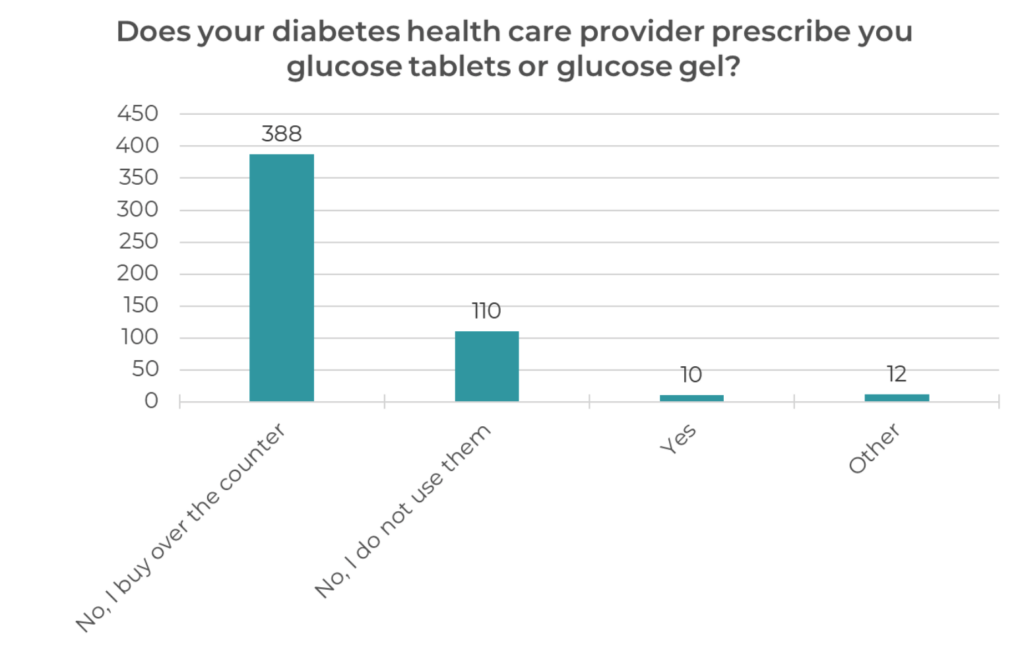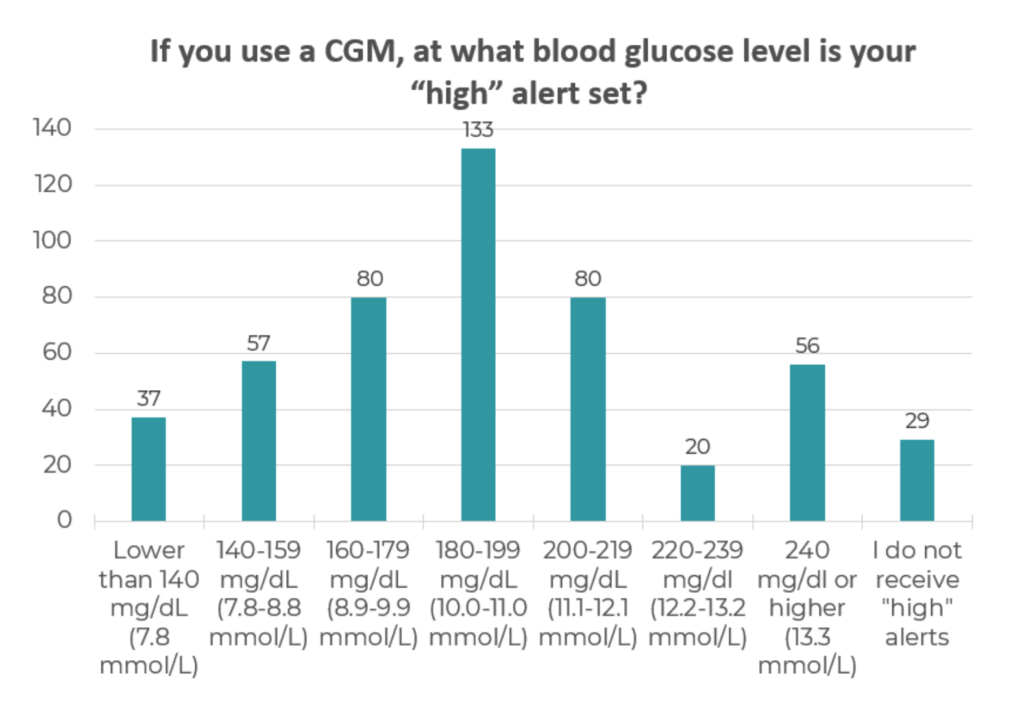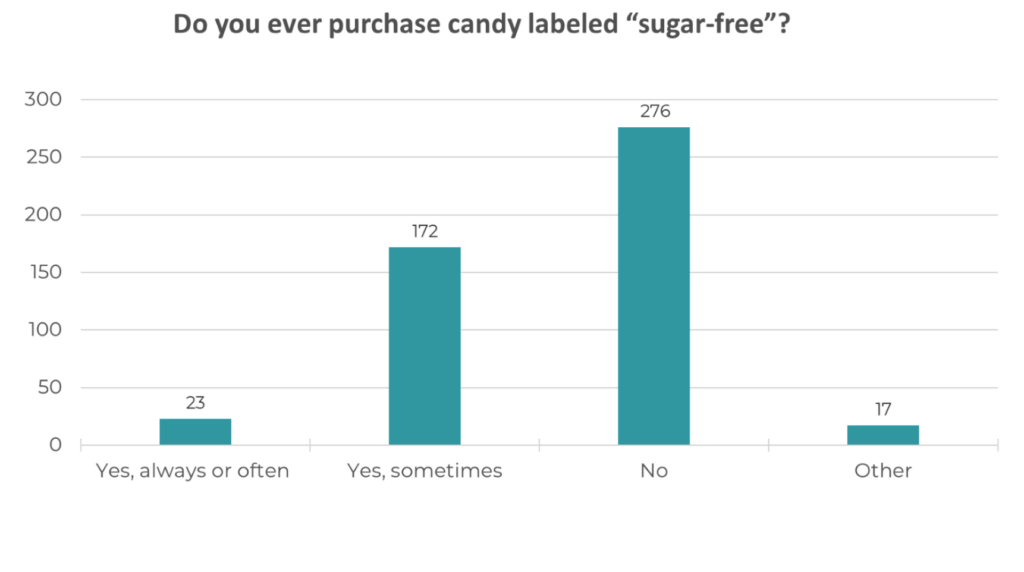
Sign up for a new account.
And get access to
The latest T1D content
Research that matters
Our daily questions
Sign up by entering your info below.
Reset Your Password
Don't worry.
We will email you instructions to reset your
password.
Thank you to every member of the T1D Exchange Online Community for answering the Questions of the Day, inspiring others, and sharing your expertise with this community. Here is what we learned from the 3 most popular questions of May 2022!

Does your diabetes health care provider prescribe you glucose tablets or glucose gel?
Our most answered Question of the Day in May received 520 responses! The most common response to this question was “No, I buy glucose tablets or gel over the counter”, with 74% of respondents selecting that option. On the other hand, only 2% of respondents reported that their health care provider prescribes glucose tablets or gel for them.
In the comments of this question, many shared that they did not know that it was an option to have glucose tablets or gel prescribed. Others noted that they prefer other forms of low treatments, like candy.
Here are some popular comments from the community:
- “Huh. I never knew this was an item I didn’t have to pay fully out-of-pocket for. Will have to look into it; maybe I’d be able to get the lemon ones I used to buy, instead of the orange or truly terrible “raspberry” flavors.”
- “Agree – never knew I could. I actually prefer glucose tablets over eating other things because I feel I can control myself better not to overeat. I am fortunate to be fiscally comfortable and would not burden the system in this way because as shown in comments, we all have our preferences. However, anyone else should get whatever they need however they can economically.”
- “I buy smarties, but finally found the efficient way to make my own small sugar tablets…
Just increase the powdered sugar on the website below as much as possible without the need for the coloring or lemon unless it is desired. Sugar and water are much less expensive than candy or glucose tablets. https://www.cutoutandkeep.net/projects/placebo-pills” - “She wrote me an RX for an inhaled substance, but I prefer to use just cheap effective sugar cubes. Two to three sugar cubes (8 to 12 grams sugar) is almost always effective in minutes. And won’t result in boomerang highs hours later like candy bars or ice cream, etc.”

If you use a CGM, at what blood glucose level is your “high” alert set? If you use multiple alert schedules, select the number that is your “high” alert at midnight in your time zone.
Our second most answered Question of the Day from May had over 500 responses. The most common response was that people set their high alert on their CGM between 180-199 mg/dL
(10.0-11.0 mmol/L). This answer had 26% of responses. The least selected answer by respondents was setting their high alert on their CGM between 220-239 mg/dL (12.2-13.2 mmol/L), with only 4% of respondents choosing that answer.
From the comments, it seems that most of our community likes to keep their CGM readings under the 200 mg/dL (11.0 mmol/L) mark.
Here are some popular comments from the community:
- “Day is 140. I used to have 140 for both, now that I’m closed loop, I know it’ll take care of it so I moved it to 180 at night. If I get that high at night I know something is wrong, possibly a bad site before it gets worse.”
- “I have my high alert off, but if I did have it, would be set at 160. I find the “rising quickly” alarms more useful and less annoying. Can definitely get “alert fatigue” if every alert available on the G6 is on. “
- “While not recommended, I turn off ALL the alarms I can. I find I check my CGM readings very regularly, especially after I have eaten or had to guesstimate the carbs in some meal I didn’t cook. My CGM and pump both have way too many alarms and they go off constantly. It’s embarrassing and annoying for me when I am with others.”
- “I keep mine set to 150 all the time, but it’s only set as a “vibrate” setting on my pump so it’s not as loud, but I notice it! I almost always will do a correction if I’m at 150 and prefer to not get that high even…”

Do you ever purchase candy labeled “sugar-free”?
Our third most popular Question of the Day from May was about purchasing candy that is labeled “sugar-free”. We had 488 respondents answer and 57% of respondents said they do not purchase candy labeled sugar-free. Only 5% of the respondents said they always or often purchase candy labeled sugar-free.
The comments emphasized that sugar-free candy still has carbs and isn’t always the healthiest option, so many people would rather purchase regular candy.
Here are some popular comments from the community:
- “Sugar free candy usually has approximately the same amount of carbohydrates as regular and tastes horrid. Dove chocolate has 5g and I don’t feel like I am punishing myself.”
- “I did one in the past. Sugar-free still has carbs. I bought a bag of sugar-free Reese’s pieces once and it didn’t work out that well (it raised my BG). Now, if I really want something like that, I buy a SMALL piece of dark chocolate and spread a dab of peanut butter on it.”
- “I used to, until I figured out that it is really not worth it. Now I just eat candy every once in a while and bolus for it.”
- “Have tried sugar free chocolate. Has after taste to me. Not worth it to save a few carbs. I only like dark chocolate so lower in sugar.”
- “I got really sick once when I was a kid from eating sugar free candy. The sugar substitute gave me gas and I was sick to my stomach for hours. It’s not worth it.”
- “I will sometimes buy sugar free hard candy or cough drops but that’s it. The sugar free versions usually have the same calories and often come with the added bonus of gastric distress. I did buy sugar free chocolate once on purpose when I was constipated.”
If you are not already a member of the T1D Exchange Online Community, join us by clicking the “Join” button at the top of this page!







